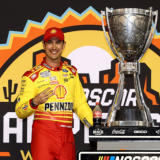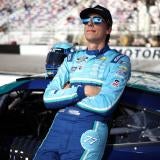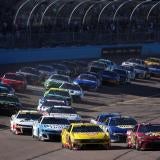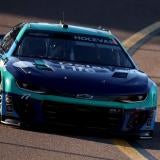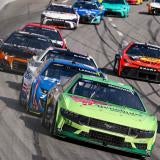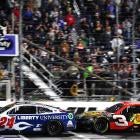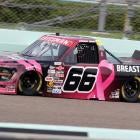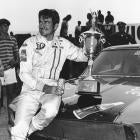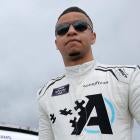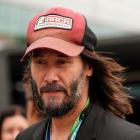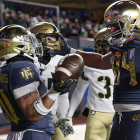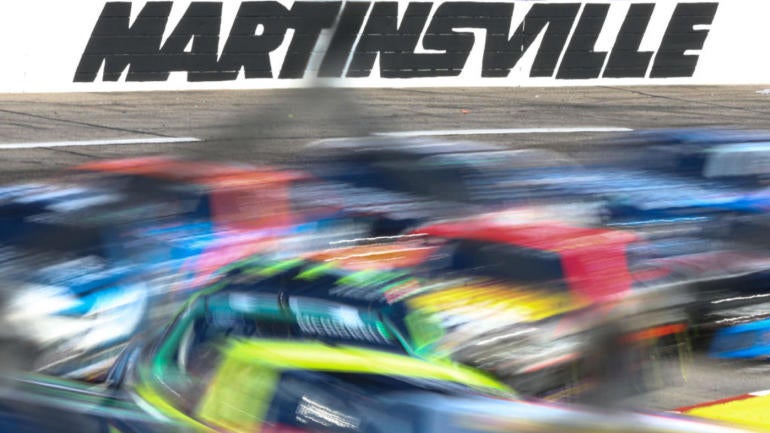
William Byron and Christopher Bell sat outside their cars, wrapped in suspense shortly after Sunday's NASCAR Cup Series race ended at Martinsville Speedway. A full 500 laps of racing should have determined which one made the Championship 4.
Instead, minutes felt like an eternity -- 5, 10, 15, 20 -- as both drivers waited for officials in the NASCAR tower to decide for them. The worst-case scenario for any major sport's title fight had come to pass: referees forced to figure out who cheated the least.
As they stood, frozen in time, every second saw NASCAR's reputation -- and the 20 years it's used a postseason format to determine its champion -- took a hit from which it may not easily recover.
"This should be the last straw," Brad Keselowski said on X Sunday night, "On the camel's back for the playoffs."
In the end, Byron got the nod for a title. But even he wasn't happy under the circumstances.
"It is what it is," Byron said upon hearing the news. "I will go race."
Things all came to a head during a final stage that unfolded with both drivers struggling to hang on. Bell had an awful day, involved in the first caution of the race on Lap 77 and never getting the track position he truly needed. After pitting twice for a loose wheel, he lost a lap under green and gave up precious points to Byron.
It appeared Byron would then advance, clinching one of two Championship 4 spots still available under NASCAR's format along with whichever playoff driver (Ryan Blaney, Kyle Larson, Chase Elliott) won the race. But as the laps wound down, Byron started to suffer himself after contact made with Shane van Gisbergen and Blaney.
"We had damage ever since the 12 shipped the 16 car out of the way," Byron explained on pit road. "Screwed up our toe."
Suddenly, Byron started slipping back with poor handling and the gap between him and Bell started shrinking. It was four points. Then three. Two. One.
That's when Byron came up on two friendly drivers behind him, both driving Chevrolets: Ross Chastain and Austin Dillon. Neither had much to race for, but their manufacturer sure did: with Blaney's Ford taking the lead, Byron was the only Chevy positioned to reach the Championship 4.
From public radio transmissions, it appeared a plan was hatched to keep it that way.
Radio comms between Ross Chastain and Austin Dillon’s crews.@AlwaysRaceDay pic.twitter.com/MLLFr6mBmi
— Mr Matthew CFB (@MrMatthew_CFB) November 3, 2024
"You know the deal?" Dillon's radio said. "Does the No. 1 crew chief know the deal? Yeah, he should."
Shortly thereafter, Chastain and Dillon started racing side-by-side, lap-by-lap, behind Byron as other cars stacked up behind them. It meant no one could pass Byron, creating a scenario where he could advance by one point into the championship.
Bell appeared stuck … until the final lap of the race.
That's when fellow Toyota driver Bubba Wallace, complaining he had a flat or "something broke," slowed dramatically on the racetrack. Wallace's last lap clocked in at 24.891 seconds; by comparison, winner Blaney ran a 21.407 and Bell a 22.506.
As Wallace slowed, it allowed Bell to get by for 18th, the first position one lap down. After passing the No. 23 car entering Turn 3, he lost control and rode the outside wall to the finish, prompting comparisons of Ross Chastain's similar wild ride two years ago.
A side-by-side comparison of Ross Chastain and Christopher Bell’s wall ride at Martinsville. #NASCAR pic.twitter.com/5pYInQk7Hh
— NASCAR on NBC (@NASCARonNBC) November 3, 2024
It was a move NASCAR later outlawed based on potential safety violations for drivers, fans and concern over a crossover gate that makes up part of the wall on Martinsville's track. Ultimately, that's what officials decided happened here after deliberating for 27 minutes, penalizing Bell and giving Byron a pass into the final round.
"I understand that the rule is made to prevent people from riding the wall," Bell said afterward. "But my move was completely different than what Ross' was. I got loose getting into the corner and slid right into the fence.
"I don't know what else to say."
Neither did anyone else as the magnitude of what transpired swept over the garage: manipulation, blocking and the type of dirty tactics no one wants to see determine a champion. Boos turned into disgust from fans, then an eerie quiet settled over the speedway as NASCAR senior vice president of competition Elton Sawyer claimed "we'll look at everything" this week while a furious Joe Gibbs was told his No. 20 team could not appeal the "safety violation" that shuttered their chance at a title.
Instead, the judgment could end in much deeper consequences: changing the NASCAR postseason format as we currently know it.
Traffic Report
Green: Ryan Blaney. Lost in the shuffle was a phenomenal comeback by Blaney, closing a 2.5-second gap during the final 87 laps to pass good friend Chase Elliott and earn a shot at back-to-back titles. Team Penske, with Blaney and Joey Logano, now makes up 50 percent of the Championship 4 at Phoenix along with 23XI Racing's Tyler Reddick and Byron.
Yellow: Kyle Larson. Like many outstanding years under this format, Larson's season-high six wins weren't enough for him to advance. A sloppy start to this semifinal round of 11th- and 13th-place results dug a hole a third at Martinsville could not fix. Without a playoff reset, Larson would go into NASCAR's season finale as the point leader by 25 over Chase Elliott.
Red: Kyle Busch. Barring a miracle at Phoenix, Busch's year will end without a win for the first time since moving up to the Cup level full-time in 2005. The playoffs have been filled with missed opportunities turned embarrassing moments for the two-time champion, culminating with a loose wheel that came off on track at Martinsville to produce his fourth run of 25th or worse in the last eight races.
Speeding Ticket: NASCAR. Think about the longest replay challenge you've seen in the NFL this season. That took less than one-third of the 27 minutes it took for NASCAR to come up with an answer on a penalty. The gravitas of who makes the championship added to the drama but to be caught that flat-footed? There's a moment where you go from being deliberate to damaging when taking too long to make a decision as a sanctioning body.
I fear that's where we are post-Martinsville. And we're just at the start of what promises to be an exhaustive investigation of how an ugly end to the race unfolded.
Oops!
Adding insult to injury for NASCAR was officials allowing a restart on Lap 407 even though Busch's tire had rolled its way on track.
Caution for a tire coming off of the 8 of Kyle Busch #NASCAR Will be held two laps and will get a penalty later in the week pic.twitter.com/3oLqDVudQW
— Brett Winningham (@NASCAR_BRETT) November 3, 2024
Initially, NASCAR was going to reset the drivers in the same positions but, since the green flag had technically come out, they chose to realign the field based on where they were at the moment of caution. The tire just wasn't caught in time.
That didn't sit well with winner Blaney, who cussed out NASCAR on the radio after the decision and whose lost track position, he claimed, almost cost him the race.
"The restart deal didn't help us," Blaney explained. "When [Busch] lost his wheel, I lost two spots there. I didn't understand. We didn't pass the start/finish line when the caution came out, at least I didn't think so. I lost two spots. Damn, I had to restart like 10th."


